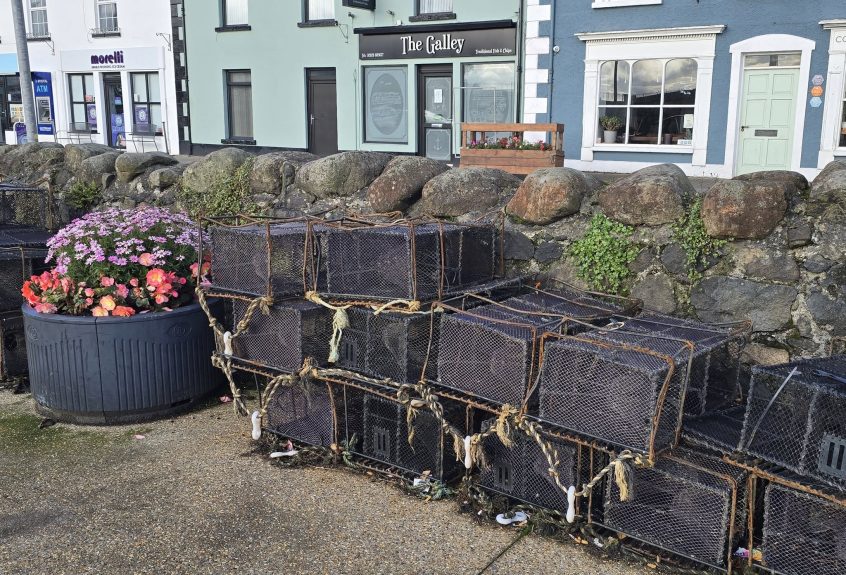When I left my hotel this morning, I didn’t have high hopes for the weather. It’s been thwarting my plans for days, and the gray sky, low clouds, and drizzle didn’t look promising.
I’d signed up for a tour of the Causeway Coastal Route and the Giant’s Causeway. The bus left promptly at 8:30, and the day turned into a whirlwind of scenery and stops. Part of me wished I’d rented a car to linger at places that caught my eye, but the narrow, winding roads and driving on the opposite side made me grateful for a professional behind the wheel.
Our driver and guide, Jan, had the gift of gab. He could spin the smallest incident into a ten-minute tale, many of them involving Game of Thrones scenes filmed along this coast. I’ve never watched the series, but by the end of the day I felt like I’d been given a crash course. Jan didn’t stop talking for the full ten hours; between the driving and the storytelling, he must have been exhausted by the time we returned to Belfast.
The first stop was a photo break at Carrickfergus Castle. I can’t tell you much about the history—I was too busy battling the cold, wind, and damp to absorb anything.
But once we entered the Causeway Coastal Route, the scenery took over. High cliffs swooped down to the water—some sheer rock, others carpeted in emerald green pastures where sheep and cows grazed as waves crashed at the shore. The weather played hide-and-seek; each time the rain stopped, a rainbow appeared. I counted six by day’s end.
In Carnlough Harbor, a fishing village in the village of Glencloy, we stretched our legs and grabbed snacks at the one open shop. Miraculously, the sun came out.
Back on the bus, we continued along the winding road, the sea on one side, hills, and fields on the other. Every turn revealed a new postcard view; tiny cottages tucked against the hillsides, fishing boats bobbing in sheltered coves, and long stretches where the sea seemed to stretch forever. Sunlight broke through the shifting clouds, spotlighting patches of impossibly green pasture or illuminating patches of water.
We rolled through villages where life seemed unhurried, with stone houses, colorful shopfronts, and pubs that looked like they’d been there for centuries. In the distance, dramatic headlands jutted into the sea. The rhythm of the route was hypnotic: rain, rainbow, sunlight, sea spray. By the time we turned inland, I felt as though I’d traveled not just through scenery, but through a living painting that changed with every mile.
Midday brought a stop at the Fullerton Arms pub in Ballintoy, a tiny, picturesque village whose harbor was used in Game of Thrones. The pub, dating back to the 19th century, has long welcomed travelers along this coast. No sooner had we climbed back on the bus than the skies opened again, followed, as if on cue, by a rainbow.
We stopped at a viewing point to see the Carrick-a-Rede Rope Bridge. It was first built by salmon fishermen in the mid-1700s to give them access to the tiny island where they set their nets during the annual migrations. Even from a distance it looked both spectacular and terrifying. Strung high above the waves, I could see it swaying in the wind. The brave souls who crossed it hung onto the rope guides as if their lives depended on them (which they did).
Only a limited number of people are allowed to cross each day, but even if I’d been offered the chance, I would have declined. I’m hopeless with heights, and with the fierce wind, just watching others inch their way across was enough to make me woozy. From a safe distance, though, it was stunning.
Then came the highlight of the tour, the Giant’s Causeway. I’d been told by several people that I shouldn’t even attempt to walk down the steep one-mile-long path to get there. Fortunately, there’s a shuttle bus for those of us unwilling or unable to walk it.
The Causeway itself is unlike anything I’ve seen: more than 40,000 interlocking basalt columns, formed sixty million years ago by volcanic activity. The tops of the columns create a surreal, stepping-stone pattern that seems almost too precise to be natural, like a giant’s handiwork rather than geology. Which is, of course, how it got its name. According to legend, the Irish giant Finn McCool built the causeway as a bridge to Scotland to challenge his rival. Standing there with the wind whipping in from the sea, it was easy to see how such myths were born; the landscape feels otherworldly, a place where giants might really have walked.
The sun was blazing during our stop, but again, just as we boarded the bus the rain began. I couldn’t believe our luck.
We had a short stop, with the sun again cooperating, at Dunluce Castle. It looks like something lifted straight from the pages of a fantasy novel. Perched dramatically on a rocky headland that drops into the Atlantic, its stone walls are jagged with age. Our stop there was very quick because the wind was fierce and the temperature chilling. Jan, our driver, told us that Dunluce Castle inspired and appeared in the Game of Thrones. Its silhouette and setting were used as the model for Pyke Castle.
Then, after two final brief and, for me, uninteresting stops we headed back into Belfast, arriving around six. It was a very long day, but one filled with rainbows, legends, and landscapes that will stay with me far longer than the damp chill.

